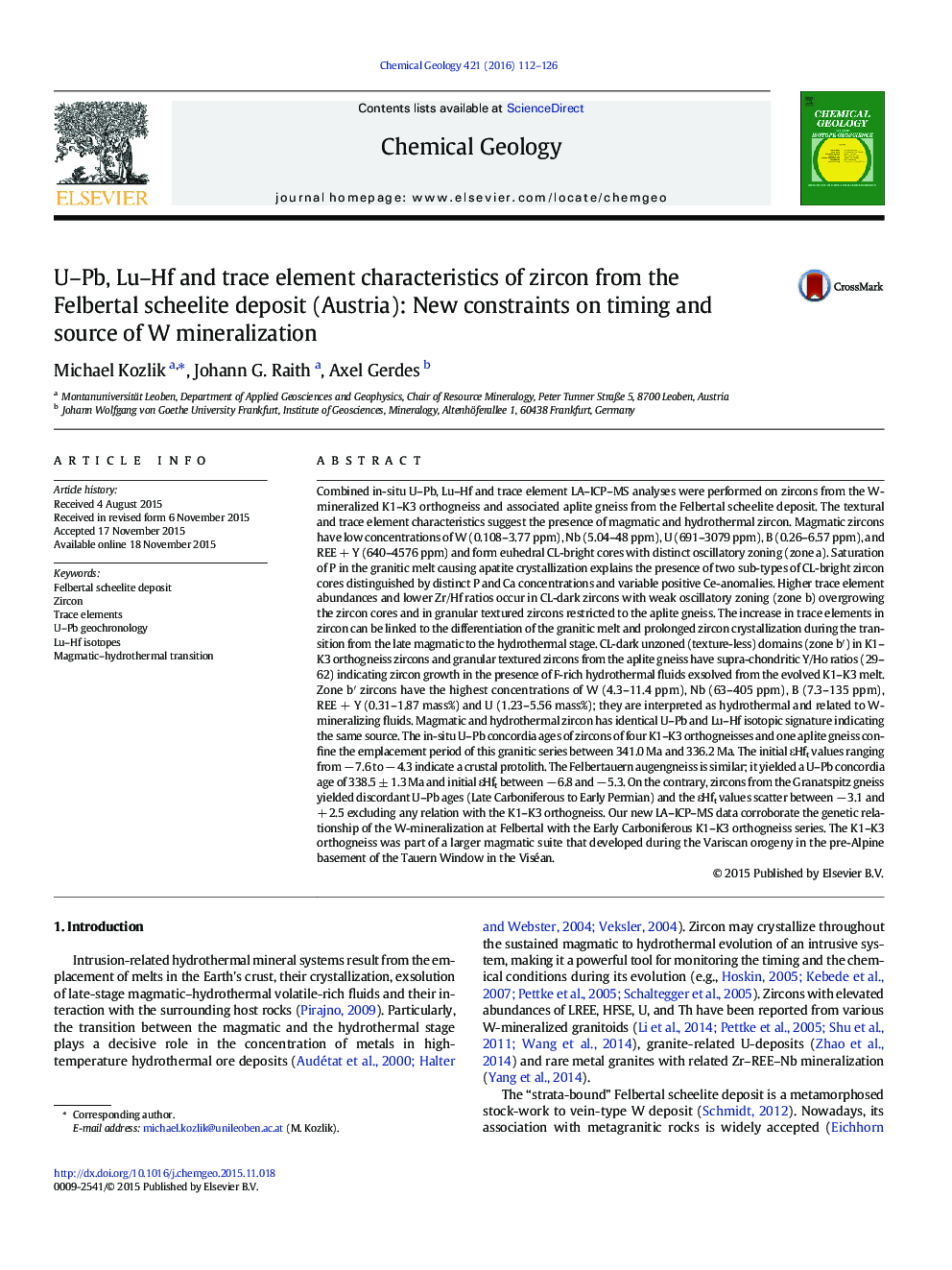| کد مقاله | کد نشریه | سال انتشار | مقاله انگلیسی | نسخه تمام متن |
|---|---|---|---|---|
| 6436180 | 1637553 | 2016 | 15 صفحه PDF | دانلود رایگان |

- Zircon records magmatic to hydrothermal evolution of a W mineralized metagranite at Felbertal scheelite deposit
- Hydrothermal zircon is trace element-rich (U, Nb, W, B) and genetically linked to ore formation.
- Variscan magmatic activity is limited to the Viséan period between 341 and 336Â Ma at Felbertal scheelite deposit.
Combined in-situ U-Pb, Lu-Hf and trace element LA-ICP-MS analyses were performed on zircons from the W-mineralized K1-K3 orthogneiss and associated aplite gneiss from the Felbertal scheelite deposit. The textural and trace element characteristics suggest the presence of magmatic and hydrothermal zircon. Magmatic zircons have low concentrations of W (0.108-3.77 ppm), Nb (5.04-48 ppm), U (691-3079 ppm), B (0.26-6.57 ppm), and REE + Y (640-4576 ppm) and form euhedral CL-bright cores with distinct oscillatory zoning (zone a). Saturation of P in the granitic melt causing apatite crystallization explains the presence of two sub-types of CL-bright zircon cores distinguished by distinct P and Ca concentrations and variable positive Ce-anomalies. Higher trace element abundances and lower Zr/Hf ratios occur in CL-dark zircons with weak oscillatory zoning (zone b) overgrowing the zircon cores and in granular textured zircons restricted to the aplite gneiss. The increase in trace elements in zircon can be linked to the differentiation of the granitic melt and prolonged zircon crystallization during the transition from the late magmatic to the hydrothermal stage. CL-dark unzoned (texture-less) domains (zone bâ²) in K1-K3 orthogneiss zircons and granular textured zircons from the aplite gneiss have supra-chondritic Y/Ho ratios (29-62) indicating zircon growth in the presence of F-rich hydrothermal fluids exsolved from the evolved K1-K3 melt. Zone bâ² zircons have the highest concentrations of W (4.3-11.4 ppm), Nb (63-405 ppm), B (7.3-135 ppm), REE + Y (0.31-1.87 mass%) and U (1.23-5.56 mass%); they are interpreted as hydrothermal and related to W-mineralizing fluids. Magmatic and hydrothermal zircon has identical U-Pb and Lu-Hf isotopic signature indicating the same source. The in-situ U-Pb concordia ages of zircons of four K1-K3 orthogneisses and one aplite gneiss confine the emplacement period of this granitic series between 341.0 Ma and 336.2 Ma. The initial ÉHft values ranging from â 7.6 to â 4.3 indicate a crustal protolith. The Felbertauern augengneiss is similar; it yielded a U-Pb concordia age of 338.5 ± 1.3 Ma and initial ÉHft between â 6.8 and â 5.3. On the contrary, zircons from the Granatspitz gneiss yielded discordant U-Pb ages (Late Carboniferous to Early Permian) and the ÉHft values scatter between â 3.1 and + 2.5 excluding any relation with the K1-K3 orthogneiss. Our new LA-ICP-MS data corroborate the genetic relationship of the W-mineralization at Felbertal with the Early Carboniferous K1-K3 orthogneiss series. The K1-K3 orthogneiss was part of a larger magmatic suite that developed during the Variscan orogeny in the pre-Alpine basement of the Tauern Window in the Viséan.
268
Journal: Chemical Geology - Volume 421, 10 February 2016, Pages 112-126